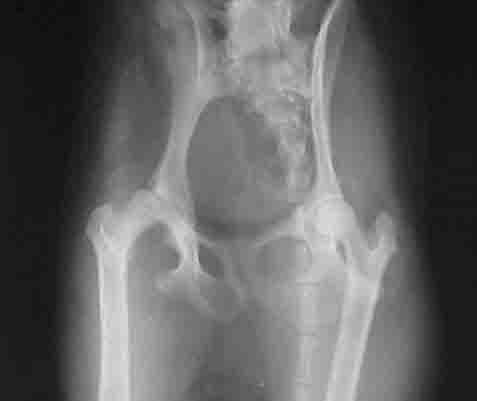Table of Contents
Summary:
"Are you seeing signs of dog lameness or weakness in the hind quarters? Have you observed your dog seaking on the rear legs while standing? Is your dog falling while walking or is it a struggle to keep the rear standing upright? If the answer is yes, then your dog could be suffering from hind quarter weakness, a condition called posterior paresis. The condition can also be accompanied by pain.
The condition refers to dogs that are unable to use one or several limbs. It is more commonly seen in older dogs (but can occur in dogs of any age) with an incidence as high as 50%. Owners should not consider this a normal part of the aging process. Lameness is a symptom that indicates many types of health problems that may need to be addressed including thyroid function, muscle disorders or even neurological conditions. The most common cause is joint injury, a fracture to a bone or a dislocated bone. Other common disorders include arthritis and hip dysplasia.
The condition may just appear one day. Be sure to keep an incident log for your veterinarian and take video using a smartphone when your dog exhibits any signs. The best approach is to identify any underlying causes and then to treat the issue with the appropriate approach which can include surgery, medictions and physical therapy among others."

Overview
Lameness can occur in any dog at any age. It refers to a dog that is unable to use one or more limbs. Common causes include:
- Young Dogs/Puppies: Problems and abnormalities during early growth stages and injury
- Adults: injuries
- Older dogs: Arthritis or a degenerative joint disease
Below are more detailed explanations of each possible cause.
Causes and Related Treatment Approaches for Dog Lameness
Nutritional and Electrolyte Deficiency
Nutrition deficiencies and imbalances can result in lameness. If this is the cause, symptoms will appear slowly and get worse over time. Electrolyte imbalances include soldium, calcium and potassium. Vitamin deficiencies result from malabsorption which is where the body does not absorb or utilize nutrients. Low electrolyte levels will reduce the capacity of muscles ot properly move or to maintain mass.
- Diagnostic Tests: Nutrition problems are detected with blood tests. The tests will check nutrient levels and how the organs are functioning.
- Treatment: A veterinarian will recommend supplements and a possible change in diet. The condition will require monitoring until normal levels are achieved.
- Prognosis: Once the underlying condition is addressed, the dog should improve gradually. Some muscle atrophy may not be reversible.
Circulatory Problems
The circulatory system suffers from vascular blockages which can limit blood flow. One condition, fibrocartilaginous embolism (FCE) as an example, is a spinal cord stroke where spinal discs move and block the flow of blood. Its' onset can be due to an accident with a higher incidence in large breeds.
- Diagnostic Tests: A veterinarian will perform a spinal myelogram CT scan test using dye and will take a thorough medical history. The CT scan can eliminate other possible causes such as tumors or diseases.
- Treatment: Some relief might be possible with aspirin or prescription medications such as steroids.
Tumors and Growths
Growths and tumors put pressure on nerves, nerve sheaths or the spinal cord. Tumors or growths can be malignant (cancerous) or benign (not cancer). Most cases occur suddenly (75%).
- Types of cancerous growths include:
- fibrosarcoma
- meningioma (benign brain tumor in most cases)
- lipoma
- osteosarcoma
- Breeds Affected:
- Golden Retrievers
- Doberman Pinschers
- Brittany Spaniels
- Irish Wolfhounds
- Gordon Setters
- Diagnostic Tests: Either X-Rays or a MRI. The MRI will indicate the size and exact tumor location
- Treatment: Any tumor will be biopsied for analysis in the lab. If surgically possible, tumors can be removed with the area treated by radiation. In cases where there is a bone tumor, treatment can include pain medications and the use of biophosphates which help maintain bone mass.
Neurological Problems and Disorders
Dogs suffer many of the same problems seen in humans including strokes and seizures. One disorder referred to as "old dog vestibular disease" impacts a nerve which connects the brain to the inner ear. Problems can start slowly or occur in as little as a few days. The prognosis depends on the ability of the veterinarian to address the underlying cause of the disease.
- Symptoms include:
- hind leg weakness
- head tilting
- dizziness
- Breeds affected:
- Doberman Pinschers
- Beagles
- English Cocker Spaniels
- Akitas
- German Shepherds
- Diagnostic Tests: Blood and imaging tests used to rule out other causes
- Treatment: Medications to address problems such as seizures or a medication called anipryl for cognitive dysfunction
Degenerative Diseases
Degenerative disease refers to the break down of nerves, ligaments, bones and muscles. Osteoarthritis is the best known of the degenerative joint diseases. Theses types of disorders occur slowly unless a dog suffers an injury. Depending on the cause, surgery to strengthen or replace joints can stabilize the hindquarters and reduce or eliminate lameness. Often degenerative diseases can be slowed down or delayed, but not cured.

Photo Credit: Washington State University
Unlike diseases that occur when a dog is older, hip dysplasia tends to start between age 5 months and 8 months. One common feature of hip dysplasia in dogs is hindquarter dog lameness.
- Diagnostic Tests: Imaging tests such as MRI, CT scan or X-Rays
- Treatment: Depends on the underlying cause of the dog lameness.
- Surgery: ligament repair, hip replacement, joint replacement
- Physical Therapy
- Acupuncture
- Weight Loss to reduce stress on the bones and joints
- Exercise
- Anti-inflammatory medications
- Nutraceuticals: glucosamine
Infections
Infectious and bacterial agents can cause issues such as ear infection or infections that affect the spine or nervous system (e.g; meningitis). Insects such as ticks can introduce toxins that cause botulism and tick paralysis. Lameness symptoms appear quickly after the infection takes hold. The prognosis depends on the disease. Those that can be treated with medications can lead to a recovery in a period of weeks to months.
- Tests: Blood tests are used to monitor white cell count levels. Other diagnostic tests include spinal taps, MRIs, X-Rays and CT scans.
- Treatment: Illness and symptoms are management with rest and fluids. Medications that target specific infections are used:
- Antibiotics
- Anti-fungal drugs
- Anti-viral drugs
- Anti-toxins
- Steroids
Metabolic and Endocrine Diseases
Several glandular disorders such as problems in the thyroid, parathyroid and adrenal glands can result in dog lameness. These diseases can cause diabetic neuropathy, poor carbohydrate metabolism, electrolyte imbalances and low circulation. Diabetic neuropathy is a disorder that causes inflammation, toxic hormone levels and muscle fiber malfunction. Some of the issues could be caused by old age itself, which effects endocrine gland function (higher incidence in female dogs).
Symptoms can be acute (come on suddenly) or slowly in the case of tumors which are negatively impacting gland function.
- Diagnostic Tests: Imaging tests such as X-Rays and CT scans. Endocrine hormone levels are tested with blood and urine tests.
Medically Induced Causes
Some medications have dog lameness as a side effect (call Iatrogenically induced) or complication of treatment. For example the widely used steroid prednisone, or pain reliever tramadol can cause lameness in dogs. Symptoms can start immediately after or shortly after taking a medication. Hindquarters leg function should return once medications are eliminated or adjusted.
- Diagnostic Tests: A veterinarian can diagnose a iatrogenic effect after taking a medical history
- Treatment: Change medications or reduce the dosage
Injury
As you could imagine any injury to muscles or bone can result in dog leg lameness. This includes aging related bone issues that result from a decline in calcium absorption, slipped discs or vertebrae and fractures that affect the pelvis or spine. Symptoms usually appear suddenly.
- Diagnostic Tests: Imaging tests such as X-Rays
- Treatment: A veterinarian will seek to stabilize any problems with surgery. Medications can help to control pain. Physical therapy can help during recovery and to improve movement.
When the Cause Cannot Be Determined
In many cases a veterinarian will not be able to make a specific diagnosis of dog lameness symptoms, called an Idiopathic cause. When this is the case a veterinarian will seek to address symptoms and keep the patient as comfortable as possible. The pet parent and veterinarian will need to review the cost of treatment and the dogs quality of life when making a treatment decision.
Support Challenges
There are many health issues and challenges that can occur along with dog lameness. These problems and potential solutions include:
Dog Lameness Support Problems and Soltuions |
|
|---|---|
| Problem | Solution |
| Incontinence | Use dog diapers and cover the dog bed with a waterproof cover |
| Elevated furniture and beds | Purchase a dog ramp |
| Difficulty climbing stairs | Buy a special sling which will support the dog when climbing stairs |
| Slipping on floors |
Add carpeting or rugs that will
not slip |
| Reluctance to walk or exercise | Change activities to meet your dog's needs |
| Cannot lean down to drink or eat | Elevate dog bowls |
